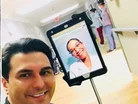How a mental healthcare practice switched to telehealth

In early March the COVID-19 pandemic caused thousands of skilled nursing homes across the US to close their doors to visitors and outside medical staff, including clinicians from Los Angeles-based Executive Mental Health (EMH), a medical practice that specialises in clinical psychology and neuropsychology.
Clinicians from the practice had regular sessions with elderly residents in nursing homes, many of whom were dealing with heightened stress and disorientation due to coronavirus. When these visits were abruptly cut off, residents became more vulnerable to the effects of the pandemic, including being at a greater risk of depression and anxiety.
This meant that in just a matter of hours, the immediate mental healthcare needs of thousands of people were put on a backburner, awaiting a solution that did not involve in-person therapy.
EMH faced a challenge. How could they move from face-to-face care to something more tech-forward, abiding by social distancing guidelines? In the end it took the practice under 3 weeks to switch to telehealth for over 100 nursing homes.
"As of March 1, EMH was providing no remote care, had not purchased any equipment to offer this service, and had not conceptualized the logistics of delivering an effective telehealth model" explained EMH’s CEO and president, Dr. Ari D. Kalechstein. "In just three weeks our team had set up the system protocol and launched it to over 100 partner facilities.”
For Dr. Kalechstein, the way to this was simple - find the right software and hardware, and train the team appropriately. “The team sourced HIPAA-approved teleconferencing programs to optimize the communication between patients and doctors, purchased tablets and stands for facilities and set up wifi contracts with service providers.”
The nursing homes supported by EMH were given newly created materials on telehealth, including set-up instructions.
Additionally they created a new position - that of Device Technician, someone who reduces the chances of a device becoming a vector for disease transmission, by being the only person using it. This eased the burden on clinicians to focus on providing mental health care to those who needed it most. A Device Technician training handbook was also created with procedures and safety guidelines.
Overall, the transition was a success. “In March, it was do or die" Dr. Kalechstein said, "specifically, as facilities closed their doors to outside visitors, EMH decided to reinvent operations to provide mental health services remotely via telehealth. Had EMH not made that existential decision, up to 60 per cent of the EMH staff could have lost their livelihood."
"Fortunately, the launch of EMH Telehealth was a success: By July 31, EMH had completed over 11,000 sessions and transitioned fully to telehealth with over 85 per cent of all psychotherapy and neuropsychological assessments carried out using the new technology. EMH also sourced, trained, and managed a team of 25 DTs, whose efforts are integral to the implementation of telehealth."



